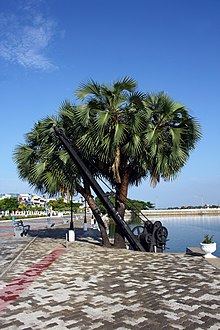Hyphaene thebaica
|
Hyphaene thebaica Doum palm |
|
|---|---|
 |
|
| Doum Palm in Batticaloa, Sri Lanka | |
| Scientific classification | |
| Kingdom: | Plantae |
| (unranked): | Angiosperms |
| (unranked): | Monocots |
| (unranked): | Commelinids |
| Order: | Arecales |
| Family: | Arecaceae |
| Genus: | Hyphaene |
| Species: | H. thebaica |
| Binomial name | |
|
Hyphaene thebaica (L.) Mart. |
|
Hyphaene thebaica, with common names doum palm (Ar: دوم) and gingerbread tree (also doom palm), is a type of palm tree with edible oval fruit. It is a native to the Arabian Peninsula and also to the northern half of Africa where it is widely distributed and tends to grow in places where groundwater is present. It has been shown that dietary supplementation with doum palm extract has hypotensive and hypolipidemic effects.
The doum palm is a dioecious palm and grows up to 17 m (56 ft) high. The trunk, which can have a girth of up to 90 cm (35 in), branches dichotomously and has tufts of large leaves at the ends of the branches. The bark is fairly smooth, dark grey and bears the scars of fallen leaves. The petioles (leaf stalks) are about a metre long, sheathing the branch at the base and armed with stout upward-curving claws. The leaves are fan shaped and measure about 120 by 180 cm (47 by 71 in). Male and female flowers are produced on separate trees. The inflorescences are similar in general appearance, up to about 1.2 m (3 ft 11 in) long, branching irregularly and with two or three spikes arising from each branchlet. Female trees produce large woody fruits, each containing a single seed, that remain on the tree for a long period.
The doum palm is native to the northern half of Africa. It is widespread in the Sahel and grows from Mauritania and Senegal in the west, through Central Africa, and east to Egypt, Kenya and Tanzania. It tends to grow in areas where groundwater is present and is found along the Nile River in Egypt and Sudan, in riverine areas of northwestern Kenya, and along the Niger River in West Africa. It is also native to the Levant and the Arabian Peninsula (Israel, Sinai, Yemen and Saudi Arabia. and is reportedly naturalized in the Netherlands Antilles in the Caribbean It grows in wadis and at oases, but sometimes occurs away from water and on rocky hillsides. It dislikes waterlogged soils and is very resistant to destruction by bushfires.
...
Wikipedia
